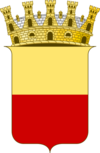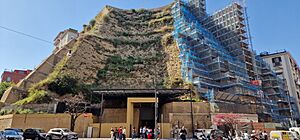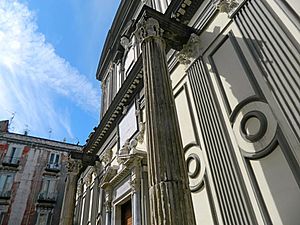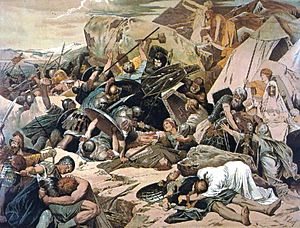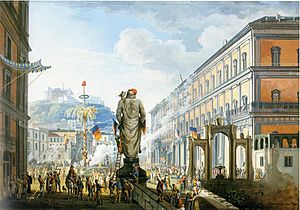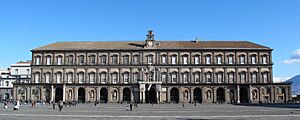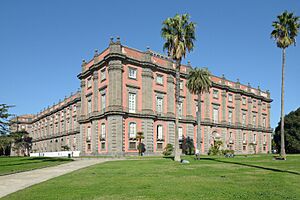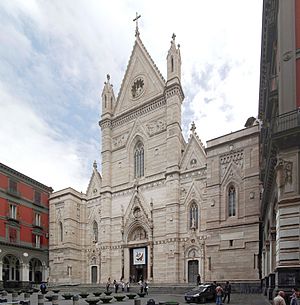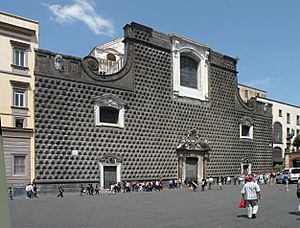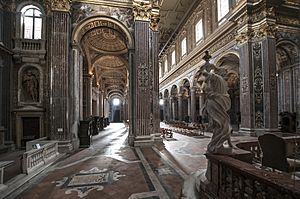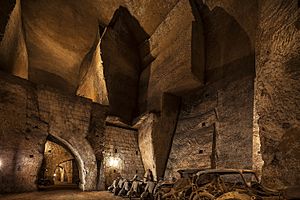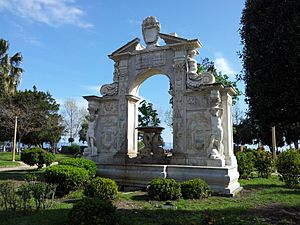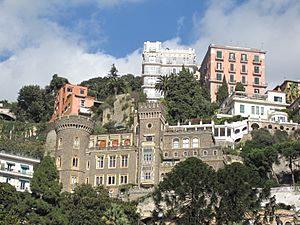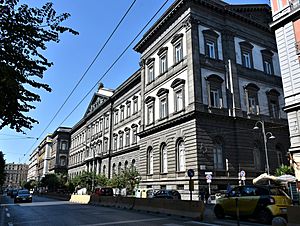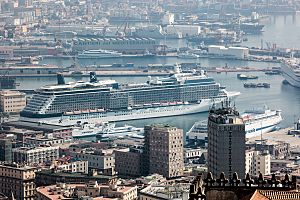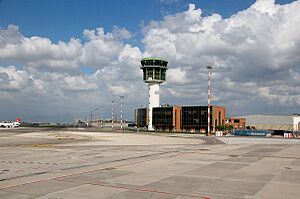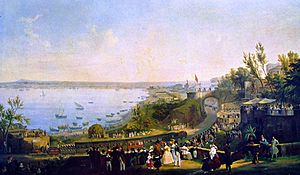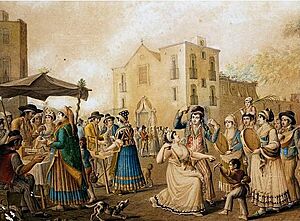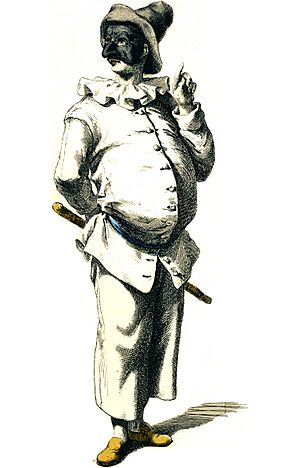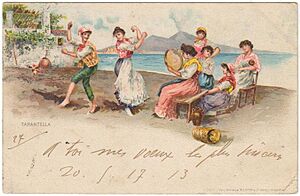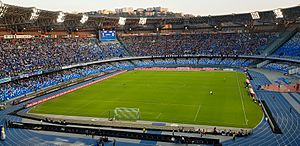Naples facts for kids
Quick facts for kids
Naples
|
|||
|---|---|---|---|
| Comune di Napoli | |||
|
Skyline of Naples with Mount Vesuvius
Piazza del Plebiscito
Castel Nuovo
Royal Palace of Naples
Centro direzionale di Napoli
|
|||
|
|||
| Nickname(s):
Partenope
|
|||
| Country | Italy | ||
| Region | Campania | ||
| Area | |||
| • Total | 117.27 km2 (45.28 sq mi) | ||
| Elevation | 99.8 m (327.4 ft) | ||
| Highest elevation | 453 m (1,486 ft) | ||
| Lowest elevation | 0 m (0 ft) | ||
| Population
(30 June 2022)
|
|||
| • Total | 909,048 | ||
| • Density | 7,751.8/km2 (20,076.9/sq mi) | ||
| Demonym(s) | Napoletano Partenopeo Napulitano (Neapolitan) Neapolitan (English) |
||
| Time zone | UTC+1 (CET) | ||
| • Summer (DST) | UTC+2 (CEST) | ||
| Postal code |
80100, 80121-80147
|
||
| Dialing code | 081 | ||
| Patron saint | Januarius | ||
| Saint day | 19 September | ||
Naples (called Napoli in Italian) is a big city in Italy. It's the capital of the Campania region. Naples is the third-largest city in Italy, after Rome and Milan. About 909,000 people live there. Its larger metropolitan area has over 3 million residents.
Naples is one of the oldest cities in the world where people have lived continuously. Greeks founded it in the first thousand years BC. A colony called Parthenope was started in the 8th century BC. Later, in the 6th century BC, it was rebuilt as Neápolis, meaning "new city." The city was a key part of Magna Graecia, which was a group of Greek colonies in southern Italy. It helped mix Greek and Roman cultures. Naples was also an important cultural center when the Romans ruled.
Naples was the capital of several kingdoms over many centuries. These included the Duchy of Naples (661–1139), the Kingdom of Naples (1282–1816), and the Kingdom of the Two Sicilies. This lasted until Italy became one country in 1861. Naples is also known as a capital of the Baroque art style. This started with the artist Caravaggio in the 17th century. The city was also important for new ideas during the Renaissance and Enlightenment. Naples has been a global center for classical music and opera through the Neapolitan School.
Between 1925 and 1936, Naples grew and improved under the Fascist government. During World War II, the city was badly damaged by Allied bombings. After the war, a lot of rebuilding work took place.
Since the late 1900s, Naples has seen good economic growth. This was helped by new business areas like the Centro Direzionale. It also got better transport, like a high-speed train link to Rome and Salerno. The subway network also expanded. Naples has the third-largest city economy in Italy by GDP, after Milan and Rome. The Port of Naples is one of the most important ports in Europe. It handles trade and is home to NATO's Allied Joint Force Command Naples.
Naples' historic city center is the largest in Europe. UNESCO has named it a World Heritage Site. Many important cultural and historical places are nearby. These include the Palace of Caserta and the Roman ruins of Pompeii and Herculaneum. Naples is also famous for its beautiful natural spots like Posillipo and Mount Vesuvius. Neapolitan cuisine is well-known for pizza, which started in the city. Many other local dishes are also popular. Naples' Centro Direzionale was Italy's first group of skyscrapers, built in 1994. The most famous sports team in Naples is the Serie A football club Napoli. They have won the Italian championship three times, most recently in 2023. They play at the Stadio Diego Armando Maradona.
Contents
History of Naples
Early Greek and Roman Times
Naples has been lived in since the Stone Age. Around 2000 BC, a settlement from Mycenae was built near where the city is now.
Sailors from the Greek island of Rhodes likely set up a small trading port. It was called Parthenope, meaning "Pure Eyes," in the 9th century BC. This was on the island of Megaride. By the 8th century BC, people from Cumae expanded the settlement to include Monte Echia. In the 6th century BC, the city was refounded as Neápolis, meaning "New City." It became one of the most important cities in Magna Graecia.
The city grew quickly because of the strong Greek city-state of Syracuse. Naples became an ally of the Roman Republic against Carthage. During the Samnite Wars, the city was captured by the Samnites. But the Romans soon took it back and made it a Roman colony. During the Punic Wars, Naples' strong walls stopped the army of the Carthaginian general Hannibal.
The Romans respected Naples as a great example of Greek culture. During Roman times, people in Naples kept their Greek language and customs. The city also grew with beautiful Roman villas, aqueducts, and public baths. Important buildings like the Temple of Dioscures were built. Many emperors, like Claudius and Tiberius, chose to vacation in Naples. Virgil, who wrote Rome's famous epic poem Aeneid, studied and lived near the city.
Christianity first came to Naples during this time. The apostles Peter and Paul are said to have preached there. Januarius, who became Naples' patron saint, was killed there in the 4th century AD. The last emperor of the Western Roman Empire, Romulus Augustulus, was sent to Naples by the Germanic king Odoacer in the 5th century AD.
Duchy of Naples
After the Western Roman Empire fell, the Ostrogoths, a Germanic group, took Naples. It became part of their kingdom. But Belisarius from the Byzantine Empire recaptured Naples in 536. He entered the city through an aqueduct.
In 543, during the Gothic Wars, Totila briefly took the city for the Ostrogoths. But the Byzantines took control again after the Battle of Mons Lactarius near Vesuvius. Naples was supposed to stay connected to the Exarchate of Ravenna, the center of Byzantine power in Italy.
After the exarchate fell, the Duchy of Naples was created. Naples kept its Greek-Roman culture. But it eventually changed its loyalty from Constantinople to Rome. This happened under Duke Stephen II in 763, putting it under the Pope's rule.
Naples became fully independent by the early 9th century. In 836, Naples allied with the Muslim Saracens. They asked for help to fight off Lombard troops from the nearby Duchy of Benevento.
By the 11th century, Naples started hiring Norman fighters to battle its rivals. Duke Sergius IV hired Rainulf Drengot to fight against Capua.
By 1137, the Normans had become very powerful in Italy. They controlled many independent areas. Naples was the last independent duchy in southern Italy. It came under Norman control that year. The last duke, Sergius VII, had to surrender to Roger II. Roger II had been named King of Sicily seven years earlier. So, Naples joined the Kingdom of Sicily, with Palermo as its capital.
Part of the Kingdom of Sicily
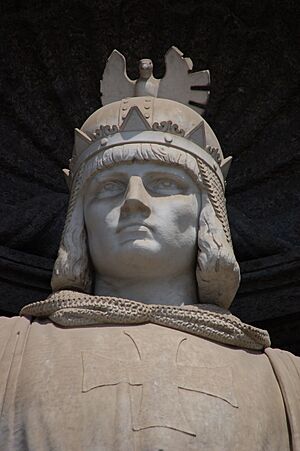
After Norman rule, the Kingdom of Sicily had a fight over who would be king in 1189. This was between Tancred, King of Sicily and the Hohenstaufens. In 1191, Henry VI, Holy Roman Emperor invaded Sicily. Many cities gave up, but Naples fought back from May to August. The Germans had to leave because of sickness. During a counterattack, Tancred captured Henry's wife, Constance. She was held at Castel dell'Ovo in Naples before being released. In 1194, Henry tried again after Tancred died. This time, Naples surrendered, and Henry took over Sicily.
Frederick II founded the University of Naples. This was the first university in Europe to train non-religious leaders. This made Naples the main center for learning in the kingdom. In 1266, the Pope crowned Charles I King of Sicily. Charles moved the capital from Palermo to Naples. He lived at the Castel Nuovo. Charles I loved architecture and brought French builders to the city. Many Gothic architecture buildings appeared in Naples, including the Naples Cathedral.
Kingdom of Naples
In 1282, after the Sicilian Vespers, the Kingdom of Sicily split into two. The Angevin Kingdom of Naples covered southern Italy. The island of Sicily became the Aragonese Kingdom of Sicily. Wars between the two royal families continued until 1302. The Peace of Caltabellotta recognized Frederick III as king of Sicily. Charles II was recognized as king of Naples.
Even with the split, Naples became more important. It attracted merchants from Pisa and Genoa, and bankers from Tuscany. Famous Renaissance artists like Boccaccio, Petrarch, and Giotto came to the city. In 1442, Alfonso I conquered Naples. He defeated the last Angevin king, René. Naples and Sicily were briefly united again.
Aragonese and Spanish Rule
Sicily and Naples were separate after 1282. But they remained under Aragon rule with Ferdinand I. The new rulers improved Naples' trade by connecting with the Iberian Peninsula. Naples also became a center of the Renaissance. Artists like Laurana and da Messina came to the city. In 1501, Naples was directly ruled by France under Louis XII. The Neapolitan king Frederick was taken prisoner to France. But this didn't last long. Spain won Naples from the French at the Battle of Garigliano in 1503.
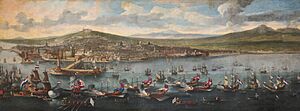
After Spain won, Naples became part of the Spanish Empire. It stayed that way during the Spanish Habsburg period. Spain sent viceroys to Naples to handle local matters. One important viceroy was Pedro Álvarez de Toledo. He made big changes to the city's society, economy, and buildings. In 1544, about 7,000 people were taken as slaves by Barbary pirates.
By the 17th century, Naples was Europe's second-largest city, after Paris. It was the biggest city in the Mediterranean, with about 250,000 people. The city was a major cultural center during the Baroque era. Artists like Caravaggio and Salvator Rosa lived there. Philosophers like Giordano Bruno and Giambattista Vico also made Naples their home. A revolt led by a fisherman named Masaniello created a short-lived independent Neapolitan Republic in 1647. But Spanish rule returned after a few months. In 1656, a terrible plague killed about half of Naples' 300,000 people.
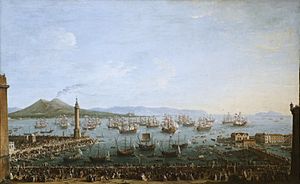
In 1714, Spanish rule over Naples ended because of the War of the Spanish Succession. The Austrian emperor Charles VI then ruled the city from Vienna. But the War of the Polish Succession brought the Spanish back. The 1738 Treaty of Vienna recognized Naples and Sicily as independent. They were ruled by a branch of the Spanish Bourbon family.
In 1755, a detailed map of Naples was made. It was known as the Map of the Duke of Noja. This map was very accurate and helped plan the city's growth.
During the time of Ferdinand IV, the ideas of the French Revolution reached Naples. Horatio Nelson warned against the French republicans in 1798. Ferdinand had to leave and fled to Palermo. There, a British fleet protected him. However, Naples' working class, called lazzaroni, were very religious and loyal to the king. They fought against the Neapolitan nobles who supported the French. This caused a civil war.
Eventually, the republicans took Castel Sant'Elmo and declared a Parthenopaean Republic. The French Army supported them. But a group of royalist lazzaroni called the sanfedisti fought back. They were very successful, and the French had to give up the castles.
Ferdinand IV became king again. However, after only seven years, Napoleon conquered the kingdom. He put his own family members, like his brother Joseph Bonaparte, on the throne. With help from the Austrian Empire, Napoleon's forces were defeated in the Neapolitan War. Ferdinand IV got his throne back.
Independent Two Sicilies
The Congress of Vienna in 1815 combined the kingdoms of Naples and Sicily. They formed the Kingdom of the Two Sicilies, with Naples as the capital. In 1839, Naples became the first city in Italy to have a railway. This was the Naples–Portici railway.
From Italian Unification to Today

After the Expedition of the Thousand led by Giuseppe Garibaldi, Naples became part of the Kingdom of Italy in 1861. This was part of the Italian unification, ending Bourbon rule. The economy of southern Italy, which relied on farming, struggled. This led to many people leaving the Naples area. About 4 million people emigrated between 1876 and 1913.
In the 40 years after unification, Naples' population grew by only 26%. Turin grew by 63% and Milan by 103%. However, by 1884, Naples was still the largest city in Italy. It had 496,499 people.
Public health was poor in some parts of the city. There were 12 outbreaks of cholera and typhoid fever. These killed about 48,000 people between 1834 and 1884. In 1884, a major cholera epidemic hit Naples. This was largely due to the city's poor sewerage system. To fix these problems, the government started a big project in 1885. It was called risanamento. The goal was to improve sewers and replace crowded areas with wide, airy streets. This project faced many delays. But it led to important changes like the building of Via Caracciolo and Galleria Umberto I.
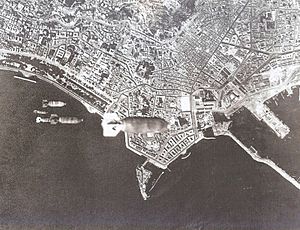
Naples was the most bombed Italian city during World War II. Even though Neapolitans did not rebel under Italian Fascism, Naples was the first Italian city to rise up against German military occupation. For the first time in Europe, the Nazis negotiated a surrender with the rebels. The city was completely free by October 1, 1943, when British and American forces arrived. The Germans burned the university library and city archives when they left. Time bombs planted throughout the city kept exploding into November. The rebuilding of the church of Santa Chiara, which was destroyed in a bombing raid, became a symbol of Naples' rebirth.
Special money from the Italian government helped Naples' economy improve from 1950 to 1984. City landmarks like the Piazza del Plebiscito were renovated. However, high unemployment continues to be a problem in Naples.
Naples has hosted several international events. These include the World Urban Forum in 2012 and the International Astronautical Congress in 2012. In 2013, it hosted the Universal Forum of Cultures. It also hosted the 2019 Summer Universiade.
Architecture in Naples
UNESCO World Heritage Site
| UNESCO World Heritage Site | |
|---|---|
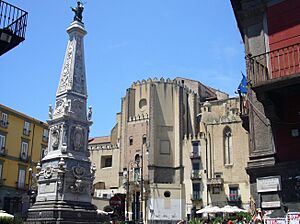 |
|
| Criteria | Cultural: ii, iv |
| Inscription | 1995 (19th Session) |
| Area | 1,021 ha |
| Buffer zone | 1,350 ha |
Naples has a long history of 2,800 years. This has left it with many historic buildings and monuments. You can see medieval castles, classical ruins, and many important cultural sites nearby. These include the Palace of Caserta and the Roman ruins of Pompeii and Herculaneum. The BBC called Naples "the Italian city with too much history to handle" in 2017.
The main building styles you see in Naples today are Medieval, Renaissance, and Baroque. Naples has 448 historic churches, and over 1000 churches in total. This makes it one of the most Catholic cities in the world based on the number of places of worship. In 1995, the historic center of Naples was named a World Heritage Site by UNESCO. This means it's a place of great cultural importance to everyone.
Naples is one of Europe's oldest cities. Its modern city layout still shows its long and important history. The ancient Greek city of Neapolis had a grid layout, which you can still see today. This layout has continued to shape the historic center of Naples, one of the main port cities in the Mediterranean. From the Middle Ages to the 18th century, Naples was a key place for art and architecture. This is seen in its old forts, royal buildings like the Royal Palace from 1600, and the palaces and churches built by noble families.
Piazzas, Palaces, and Castles
The main city square is the Piazza del Plebiscito. King Joachim Murat started building it, and King Ferdinand IV finished it. The square is bordered by the Royal Palace on one side. On the other side is the church of San Francesco di Paola. Nearby is the Teatro di San Carlo, Italy's oldest opera house. Right across from San Carlo is Galleria Umberto.
Naples is famous for its castles. The oldest is Castel dell'Ovo ("Egg Castle"). It was built on the small island of Megarides. This is where the first Greek settlers founded the city. In Roman times, the island was part of a villa. Later, it held Romulus Augustulus, the last Western Roman emperor, in exile.
Castel Nuovo, also called Maschio Angioino, is a top city landmark. It was built when Charles I was the first king of Naples. Many important events happened at Castel Nuovo. For example, in 1294, Pope Celestine V resigned as pope in a castle hall.
Castel Capuano was built in the 12th century by William I. It was expanded by Frederick II and became one of his royal palaces. The castle was home to many kings and queens. In the 16th century, it became a courthouse.
Another Naples castle is Castel Sant'Elmo. It was finished in 1329 and is shaped like a star. Its high position overlooking the city made it a target for invaders. During the uprising of Masaniello in 1647, the Spanish hid in Sant'Elmo from the rebels.
The Carmine Castle, built in 1392, was changed a lot by the Spanish in the 16th century. It was torn down in 1906 to make way for a road. But two of its towers remain as a monument.
Museums in Naples
Naples is known for its many historical museums. The Naples National Archaeological Museum is one of the city's main museums. It has one of the largest collections of Roman Empire artifacts in the world. It also holds many items found at Pompeii and Herculaneum. You can also see artifacts from the Greek and Renaissance periods.
The Museo di Capodimonte is another important museum. It used to be a Bourbon palace. The gallery has paintings from the 13th to 18th centuries. These include major works by Caravaggio and El Greco. The royal rooms have old 18th-century furniture. There is also a collection of porcelain and majolica from royal homes. The famous Capodimonte Porcelain Factory was once next to the palace.
In front of the Royal Palace of Naples is the Galleria Umberto I. It houses the Coral Jewellery Museum. The Museo d'Arte Contemporanea Donnaregina (MADRE) has modern art. The 16th-century Palazzo Roccella hosts the Palazzo delle Arti Napoli. This museum has art collections belonging to the City of Naples. It also features temporary art exhibits. Palazzo Como, from the 15th century, holds the Museo Civico Filangieri. This museum of plastic arts was created in 1883.
Churches and Religious Buildings
Naples is the home of the Archdiocese of Naples. There are hundreds of churches in the city. The Cathedral of Naples is the main church. Every year on September 19, it hosts the Miracle of Saint Januarius. He is the city's patron saint. During the miracle, thousands of Neapolitans watch. The dried blood of Januarius is said to turn to liquid. This happens when it is brought near holy relics believed to be from his body.
Here is a list of some of Naples' important churches and monasteries:
- Certosa di San Martino
- Naples Cathedral
- San Francesco di Paola
- Gesù Nuovo
- Girolamini
- San Domenico Maggiore
- Santa Chiara
- San Paolo Maggiore
- Santa Maria della Sanità, Naples
- Santa Maria del Carmine
- Sant'Agostino alla Zecca
- Madre del Buon Consiglio
- Santa Maria Donna Regina Nuova
- San Lorenzo Maggiore
- Santa Maria Donna Regina Vecchia
- Santa Caterina a Formiello
- Santissima Annunziata Maggiore
- San Gregorio Armeno
- San Giovanni a Carbonara
- Santa Maria La Nova
- Sant'Anna dei Lombardi
- Sant'Eligio Maggiore
- Santa Restituta
- Sansevero Chapel
- San Pietro a Maiella
- San Gennaro extra Moenia
- San Ferdinando
- Pio Monte della Misericordia
- Santa Maria di Montesanto
- Sant'Antonio Abate
- Santa Caterina a Chiaia
- San Pietro Martire
- Hermitage of Camaldoli
- Archbishop's Palace
Other Interesting Features
Besides Piazza del Plebiscito, Naples has two other main public squares. These are Piazza Dante and Piazza dei Martiri. The latter first had a memorial to religious martyrs. But in 1866, after Italy became one country, four lions were added. They represent four rebellions against the Bourbon rulers.
The San Gennaro dei Poveri is a Renaissance-era hospital. It was built by the Spanish in 1667 for the poor. It was a first step for a much bigger project. This was the Bourbon Hospice for the Poor. It was started by Charles III. This place was for the city's poor and sick. It also offered a self-sufficient community where the poor could live and work. It is a famous landmark, but it is no longer a hospital.
Underground Naples
Underneath Naples is a network of caves and structures. These were created over centuries of mining. The city sits on top of a major geothermal zone. There are also old Greek-Roman reservoirs. These were dug from the soft tufo stone the city is built on. About 1 kilometer of the many tunnels under the city can be visited. This is called the Napoli Sotteranea. It is in the historic center on Via dei Tribunali. This system of tunnels and cisterns is under most of the city. It is about 30 meters (98 feet) below ground. During World War II, these tunnels were used as air-raid shelters. Inscriptions on the walls show the suffering of people who hid there.
There are large catacombs in and around the city. Other landmarks include the Piscina Mirabilis. This was the main water tank for the Bay of Naples in Roman times.
Several archaeological digs are also present. They found the macellum of Naples in San Lorenzo Maggiore. In Santa Chiara, they found the city's biggest Roman bath complex.
Parks, Gardens, and Fountains
Of Naples' public parks, the most famous is the Villa Comunale. King Ferdinand IV built it in the 1780s. The park was first a "Royal Garden" for the royal family. But it was open to the public on special holidays. The Bosco di Capodimonte is the city's largest green space. It was once a royal hunting ground. The park has 16 more historic buildings. These include homes, churches, fountains, and statues.
Another important park is the Parco Virgiliano. It looks out towards the small volcanic island of Nisida. Beyond Nisida are Procida and Ischia. Parco Virgiliano is named after Virgil. He was a famous Roman poet. He is thought to be buried nearby. Naples is known for its many grand villas, fountains, and stairways. Examples include the Neoclassical Villa Floridiana and the Fountain of Neptune.
Modern Architecture
Many buildings in Naples are inspired by the Gothic Revival style. This was due to the influence of architect Lamont Young. He was very active in Naples in the late 19th and early 20th centuries. Young designed many city projects, like the first subway.
In the early 1900s, a local version of Art Nouveau developed. It was called "Liberty Napoletano." This style created many buildings that still stand today. In 1935, the Rationalist architect Luigi Cosenza designed a new fish market. During the time of Benito Mussolini, the first buildings for the city's "service center" were built. These were in a Rationalist-Functionalist style. The Centro Direzionale di Napoli is the only group of skyscrapers in southern Europe.
Geography of Naples

The city is on the Gulf of Naples, on the western coast of southern Italy. It rises from sea level to 450 meters (1,476 feet) high. The small rivers that used to cross the city center are now covered by buildings. Naples lies between two famous volcanic areas: Mount Vesuvius and the Campi Flegrei (Phlegraean Fields). Campi Flegrei is considered a supervolcano.
The islands of Procida, Capri, and Ischia can all be reached from Naples. You can take hydrofoils and ferries. Sorrento and the Amalfi Coast are south of the city. The Roman ruins of Pompeii, Herculaneum, Oplontis, and Stabiae are also nearby. These cities were destroyed when Mount Vesuvius erupted in 79 AD. The port towns of Pozzuoli and Baia are west of the city. They were part of the Roman naval base of Portus Julius.
City Quarters
The city of Naples is divided into 30 areas called quartieri. For administrative reasons, these 30 areas are grouped into 10 government community boards.
|
1. Pianura |
11. Montecalvario |
21. Piscinola |
Climate of Naples
Naples has a Mediterranean climate. This means it has mild, wet winters and hot, dry summers. The climate and fertile land around the Gulf of Naples made the region famous in Roman times. Emperors like Claudius and Tiberius vacationed near the city. The sea helps make winters milder. But it can also cause heavy rain, especially in autumn and winter. Summers have high temperatures and humidity.
Winters are mild, and snow is rare in the city. But it is common on Mount Vesuvius. November is the wettest month in Naples, while July is the driest.
| Climate data for Naples-Capodichino, district on the outskirts (altitude: 72 metres (236 feet) above sea level.) | |||||||||||||
|---|---|---|---|---|---|---|---|---|---|---|---|---|---|
| Month | Jan | Feb | Mar | Apr | May | Jun | Jul | Aug | Sep | Oct | Nov | Dec | Year |
| Record high °C (°F) | 21.1 (70.0) |
22.8 (73.0) |
27.8 (82.0) |
27.4 (81.3) |
34.8 (94.6) |
37.4 (99.3) |
39.0 (102.2) |
40.0 (104.0) |
37.2 (99.0) |
31.5 (88.7) |
26.0 (78.8) |
24.4 (75.9) |
40.0 (104.0) |
| Mean daily maximum °C (°F) | 13.0 (55.4) |
13.1 (55.6) |
15.6 (60.1) |
17.4 (63.3) |
23.0 (73.4) |
26.5 (79.7) |
29.8 (85.6) |
30.8 (87.4) |
26.8 (80.2) |
22.7 (72.9) |
17.3 (63.1) |
14.3 (57.7) |
20.9 (69.6) |
| Daily mean °C (°F) | 8.7 (47.7) |
8.8 (47.8) |
11.0 (51.8) |
12.9 (55.2) |
17.8 (64.0) |
21.3 (70.3) |
24.3 (75.7) |
24.9 (76.8) |
21.4 (70.5) |
17.1 (62.8) |
12.5 (54.5) |
9.9 (49.8) |
15.9 (60.6) |
| Mean daily minimum °C (°F) | 4.4 (39.9) |
4.5 (40.1) |
6.3 (43.3) |
8.4 (47.1) |
12.6 (54.7) |
16.2 (61.2) |
18.8 (65.8) |
19.1 (66.4) |
16.0 (60.8) |
12.1 (53.8) |
7.8 (46.0) |
5.6 (42.1) |
11.0 (51.8) |
| Record low °C (°F) | −5.6 (21.9) |
−3.8 (25.2) |
−3.6 (25.5) |
0.8 (33.4) |
5.0 (41.0) |
9.0 (48.2) |
11.2 (52.2) |
11.4 (52.5) |
5.6 (42.1) |
2.6 (36.7) |
−3.4 (25.9) |
−4.6 (23.7) |
−5.6 (21.9) |
| Average precipitation mm (inches) | 92.1 (3.63) |
95.3 (3.75) |
77.9 (3.07) |
98.6 (3.88) |
59.0 (2.32) |
32.8 (1.29) |
28.5 (1.12) |
35.5 (1.40) |
88.9 (3.50) |
135.5 (5.33) |
152.1 (5.99) |
112.0 (4.41) |
1,008.2 (39.69) |
| Average precipitation days (≥ 1.0 mm) | 9.3 | 9.1 | 8.6 | 9.3 | 6.1 | 3.3 | 2.4 | 3.7 | 6.1 | 8.5 | 10.2 | 9.9 | 86.5 |
| Average relative humidity (%) | 75 | 73 | 71 | 70 | 70 | 72 | 70 | 69 | 73 | 74 | 76 | 75 | 72 |
| Mean monthly sunshine hours | 114.7 | 127.6 | 158.1 | 189.0 | 244.9 | 279.0 | 313.1 | 294.5 | 234.0 | 189.1 | 126.0 | 105.4 | 2,375.4 |
| Source: Servizio Meteorologico and NOAA (1961–1990, humidity) | |||||||||||||
| Jan | Feb | Mar | Apr | May | Jun | Jul | Aug | Sep | Oct | Nov | Dec | Year |
|---|---|---|---|---|---|---|---|---|---|---|---|---|
| 14.6 °C (58.3 °F) | 13.9 °C (57.0 °F) | 14.2 °C (57.6 °F) | 15.6 °C (60.1 °F) | 19.0 °C (66.2 °F) | 23.6 °C (74.5 °F) | 25.9 °C (78.6 °F) | 26.0 °C (78.8 °F) | 24.9 °C (76.8 °F) | 21.5 °C (70.7 °F) | 19.2 °C (66.6 °F) | 16.4 °C (61.5 °F) | 19.6 °C (67.3 °F) |
People of Naples
| Historical population | ||
|---|---|---|
| Year | Pop. | ±% p.a. |
| 800 | 50,000 | — |
| 1000 | 30,000 | −0.26% |
| 1300 | 60,000 | +0.23% |
| 1500 | 150,000 | +0.46% |
| 1600 | 275,000 | +0.61% |
| 1700 | 207,000 | −0.28% |
| 1861 | 484,026 | +0.53% |
| 1871 | 489,008 | +0.10% |
| 1881 | 535,206 | +0.91% |
| 1901 | 621,213 | +0.75% |
| 1911 | 751,290 | +1.92% |
| 1921 | 859,629 | +1.36% |
| 1931 | 831,781 | −0.33% |
| 1936 | 865,913 | +0.81% |
| 1951 | 1,010,550 | +1.04% |
| 1961 | 1,182,815 | +1.59% |
| 1971 | 1,226,594 | +0.36% |
| 1981 | 1,212,387 | −0.12% |
| 1991 | 1,067,365 | −1.27% |
| 2001 | 1,004,500 | −0.61% |
| 2011 | 962,003 | −0.43% |
| 2021 | 921,142 | −0.43% |
| Sources: ISTAT (2001), City of Naples (2011) | ||
As of 2022, about 910,000 people live in the city of Naples. The larger metropolitan area has about 4.4 million people. The population in the Naples region is quite young. About 19% are under 14 years old. This is higher than the national average of 14%. Naples has more females (52.5%) than males (47.5%). Naples also has a higher birth rate than other parts of Italy.
Naples' population grew from 621,000 in 1901 to 1,226,000 in 1971. Then it dropped to 910,000 in 2022. This happened as people moved to the suburbs. Naples is Italy's most densely populated major city. It has about 8,182 people per square kilometer.
Compared to many northern Italian cities, Naples has fewer foreign immigrants. About 94.3% of the city's people are Italian. In 2023, there were 56,153 foreigners in Naples. Most of them are from Sri Lanka, China, Ukraine, Pakistan, and Romania. In the past, most immigrants in Naples were women. This was because male immigrants often went to wealthier northern Italy.
Education in Naples
Naples is known for its many universities and research centers. It has what is thought to be the oldest state university in the world. This is the University of Naples Federico II. Frederick II founded it in 1224. The university is one of the most important in Italy. In 2022, it had about 70,000 students and over 6,000 professors. It is home to the Botanical Garden of Naples. This garden opened in 1807. It has 15 hectares (37 acres) and about 25,000 plant samples from over 10,000 species.
Naples also has the University of Campania Luigi Vanvitelli. This modern university opened in 1989. Another important school is the University of Naples "L'Orientale". It specializes in Eastern culture. The Jesuit missionary Matteo Ripa founded it in 1732.
Other notable universities in Naples include the Parthenope University of Naples. There is also the private Suor Orsola Benincasa University of Naples. The Jesuit Theological Seminary of Southern Italy is also here. The San Pietro a Maiella music conservatory is the city's top music school. The first music conservatories in Naples started in the 16th century. The Academy of Fine Arts is the city's main art school. It is one of the oldest in Italy.
Naples also hosts the Astronomical Observatory of Capodimonte. It was set up in 1812. The Stazione Zoologica Anton Dohrn is the world's oldest marine zoological study station. It was created in 1872. The Vesuvius Observatory is the world's oldest permanent volcano observatory. It was founded in 1841. It is on the slopes of Mount Vesuvius.
Economy of Naples
Naples is Italy's fourth-largest economy within its city limits. It comes after Milan, Rome, and Turin. It is the world's 103rd-largest city economy. The port of Naples is one of the largest and busiest in the Mediterranean. The city has grown a lot economically since World War II. However, joblessness is still a big problem.
Naples is a major tourist destination in Italy and Europe. Tourists started visiting Naples in the 18th century during the Grand Tour.
In recent decades, Naples has moved away from a farming-based economy. Now, it focuses more on service industries. Most Neapolitans work in the service sector. Many of these are small businesses with fewer than 20 workers.
Tourism in Naples
Naples is one of Italy's main tourist spots, along with Florence, Rome, Venice, and Milan. In 2018, it had 3.7 million visitors. The city has fully recovered from a time when fewer tourists visited. This was partly because it was seen as an industrial city. It was also affected by image problems from the 1980 earthquake and waste issues.
Many tourists visit Naples each year. They often stay in nearby towns and take day trips into the city. Naples is the tenth most visited city in Italy. It is the most visited city in Southern Italy.
The tourism sector is growing steadily. It is becoming very important for the city's economy. Because of this, there is a risk of the historic center becoming too focused on tourism.
Transportation in Naples
Naples is served by several major highways, called autostrade in Italian. The Autostrada A1 is Italy's longest highway. It connects Naples to Milan. The A3 goes south from Naples to Salerno. From there, the highway to Reggio Calabria begins. The A16 goes east to Canosa. The A16 is called the autostrada dei Due Mari ("Motorway of the Two Seas"). This is because it connects the Tyrrhenian Sea to the Adriatic Sea.
Suburban train services are provided by several companies. These include Trenitalia, Circumvesuviana, and Metronapoli.
The city's main train station is Napoli Centrale. It is located in Piazza Garibaldi. Other important stations are Napoli Campi Flegrei and Napoli Mergellina. Napoli Afragola serves high-speed trains. Naples' streets are famously narrow. It was the first city in the world to have a pedestrian one-way street. So, people often use small cars and scooters to get around. Since 2007, high-speed trains connect Naples with Rome in under an hour. Direct high-speed services also go to Florence, Bologna, Milan, and Turin.
The port of Naples has many ferry and hydrofoil lines. They go to Capri, Ischia, Sorrento, and other places. Services are also available to Sicily and Sardinia. The port serves over 6 million local passengers each year. It also serves 1 million international cruise ship passengers.
The Naples International Airport is in the suburb of San Pietro a Patierno. It is the largest airport in southern Italy. About 250 national and international flights arrive or depart daily.
The average commute using public transport in Naples is 77 minutes on a weekday. About 19% of public transport users ride for more than 2 hours daily. The average wait time at a stop is 27 minutes. About 56% of riders wait for over 20 minutes. The average distance people travel in one trip is 7.1 kilometers (4.4 miles).
City Public Transport
Naples has a large public transport network. This includes trams, buses, and trolleybuses. Most are run by the city-owned company Azienda Napoletana Mobilità (ANM). Some suburban services are run by AIR Campania.
The city also has the Naples Metro (metropolitana di Napoli). This is an underground rapid transit railway system. It includes both surface train lines and the city's metro stations. Many of these stations are known for their beautiful design and public art. The Toledo station is often ranked as one of the most beautiful metro stations in the world.
There are also four funiculars in the city. These are Centrale, Chiaia, Montesanto, and Mergellina. Four public elevators operate in the city. They are located near the Chiaia bridge, in via Acton, near the Sanità Bridge, and in the Ventaglieri Park. There are also two public escalators.
Culture in Naples
Art in Naples
Naples has long been a center for art and architecture. It is filled with churches, castles, and palaces from the Medieval, Baroque, and Renaissance periods. A key moment for Neapolitan painting was when Caravaggio arrived in Naples in 1606. In the 18th century, Naples saw a period of neoclassicism. This followed the discovery of the well-preserved Roman ruins of Herculaneum and Pompeii.
The Neapolitan Academy of Fine Arts was founded in 1752. It was a center for the artistic School of Posillipo in the 19th century. Artists like Domenico Morelli worked in Naples then. Many of their works are now in the academy's art collection. The modern Academy teaches painting, sculpture, design, and more. Naples is also known for its theaters, which are among the oldest in Europe. The Teatro di San Carlo opera house dates back to the 18th century.
Naples is also home to the art of Capodimonte porcelain. In 1743, Charles of Bourbon founded the Royal Factory of Capodimonte. Many of its artworks are now in the Museum of Capodimonte. Several of Naples' porcelain factories from the mid-19th century are still active today.
Food and Drink in Naples

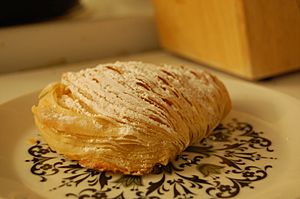
Naples is famous around the world for its food and wine. Its food has been influenced by many cultures over history. These include the Greeks, Spanish, and French. Neapolitan cuisine became its own distinct style in the 18th century. The ingredients are usually rich in flavor and affordable.
Naples is traditionally known as the birthplace of pizza. It started as a meal for poor people. But under Ferdinand IV, it became popular with the upper classes. The Margherita pizza was famously named after Queen Margherita of Savoy. It was named after her visit to the city. Traditional Neapolitan pizza is cooked in a wood-burning oven. Its ingredients have been strictly controlled by law since 2004. They must include specific types of flour, yeast, water, tomatoes, mozzarella, sea salt, and extra virgin olive oil.
Spaghetti is also linked to the city. It is often eaten with clams, called vongole. A popular Neapolitan character is Pulcinella eating a plate of spaghetti. Other popular dishes in Naples include Parmigiana di melanzane and casatiello. As a coastal city, Naples is also known for many seafood dishes. These include impepata di cozze (peppered mussels) and alici marinate (marinated anchovies).
Naples is well known for its sweet dishes. These include colorful gelato, which is like ice cream but more fruit-based. Popular Neapolitan pastries include zeppole, babà, sfogliatelle, and pastiera. The pastiera is made especially for Easter. Another seasonal sweet is struffoli, a honey dough eaten around Christmas. Neapolitan coffee is also highly praised. The traditional Neapolitan flip coffee pot, called the cuccuma, inspired the espresso machine.
Wineries in the Vesuvius area make wines like Lacryma Christi ("tears of Christ"). Naples is also the home of limoncello, a popular lemon liqueur. In May 2024, Time Out named Naples the best city for food.
Festivals in Naples
Naples' cultural importance is often shown through its festivals. Here are some festivals that take place in Naples (some are not held every year):
- Festa di Piedigrotta ("Piedigrotta Festival") – This is a music event usually held in September. It honors the famous Madonna of Piedigrotta. Throughout the month, there are music workshops, concerts, religious events, and children's events. They entertain people in Naples and nearby areas.
- Pizzafest – Naples is famous for pizza. So, the city hosts an eleven-day festival just for this iconic dish. This is a key event for both Neapolitans and tourists. You can taste many kinds of real Neapolitan pizza. Besides pizza tasting, there are also various entertainment shows.
- Maggio dei Monumenti ("May of Monuments") – This is a cultural event where the city hosts special events. They celebrate the birth of King Charles of Bourbon. The festival features 18th-century art and music. Many buildings that are usually closed are opened for visitors.
- Il Ritorno della festa di San Gennaro ("The Return of the Feast of San Gennaro") – This is an annual three-day celebration of faith. It honors Saint Gennaro. The festival includes parades, religious processions, and music. A similar celebration is also held in "Little Italy" in Manhattan.
Language of Naples

The Neapolitan language is considered a separate language. It is mainly spoken in Naples and the Campania region. It has also spread to other parts of Southern Italy because of Neapolitan migrants. On October 14, 2008, a regional law was passed in Campania. This law protects the use of the Neapolitan language.
The term "Neapolitan language" often describes the language of all of Campania. It is sometimes used for all of southern Italian dialects. Ethnologue calls this group Napoletano-Calabrese. This language group is spoken across most of southern mainland Italy. In 1976, there were an estimated 7 million native speakers of these dialects.
Literature and Philosophy
Naples is one of the main centers of Italian literature. The history of the Neapolitan language is closely tied to the Tuscan dialect. This dialect later became the Italian language we know today. The first written examples of the Italian language are legal documents from 960 A.D. They are kept in the Monte Cassino Abbey. These documents show a language spoken in a southern dialect. The Tuscan poet Boccaccio lived for many years at the court of King Robert the Wise. He also lived with his successor Joanna of Naples. Boccaccio used Naples as a setting for The Decameron and other novels. His works include some words from Neapolitan.
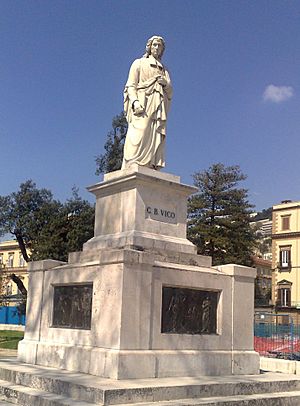
Later, Italian replaced Neapolitan in official documents in the 16th century. This happened during Spanish rule. In 1458, the Accademia Pontaniana was founded in Naples. It was one of the first academies in Italy. In 1480, the writer and poet Jacopo Sannazaro wrote the first pastoral romance, Arcadia. This book influenced Italian literature. In 1634, Giambattista Basile collected Lo Cunto de li Cunti. These were five books of old tales written in the Neapolitan dialect. Philosopher Giordano Bruno studied at the University of Naples. He believed in infinite solar systems and an infinite universe. Thanks to philosophers like Giambattista Vico, Naples became a center for historical studies.
Legal studies grew in Naples because of important lawyers like Bernardo Tanucci. In the 18th century, Naples, along with Milan, became a key place where the Enlightenment ideas entered Italy. Poet and philosopher Giacomo Leopardi visited Naples in 1837 and died there. His works influenced Francesco de Sanctis. De Sanctis studied in Naples and later became a government minister.
Writer and journalist Matilde Serao co-founded the newspaper Il Mattino in 1892. Serao was a famous novelist. Poet Salvatore Di Giacomo was one of the most famous writers in the Neapolitan dialect. Many of his poems were set to music and became famous Neapolitan songs. In the 20th century, philosophers like Benedetto Croce continued the long tradition of philosophy in Naples.
Theatre in Naples
Naples was one of the places where modern theater began. It developed from 16th-century commedia dell'arte. The masked character of Pulcinella is famous worldwide. He is known as a theater character and a puppet character.
The music opera style of opera buffa was created in Naples in the 18th century. Then it spread to Rome and northern Italy. In the Belle Époque period, Naples competed with Paris for its café-chantants. Many famous Neapolitan songs were first created to entertain people in Naples' cafes. Perhaps the most well-known song is "Ninì Tirabusciò."
The Neapolitan popular style of sceneggiata is an important type of modern folk theater. It tells common stories of love that goes wrong, comedies, and sad tales. These are often about honest people who become outlaws due to bad events. The Sceneggiata became very popular in Naples. It also became well-known in Italian movies thanks to actors and singers like Mario Merola. Many writers wrote comedies and dramas for this style. Actors and comedians like Eduardo Scarpetta and his children helped make Neapolitan theater famous. Their comedies and tragedies, like "Filumena Marturano", are well-known.
Music in Naples
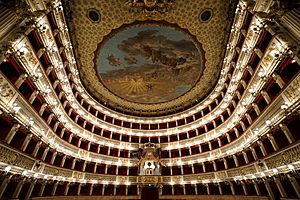
Naples has been very important in Western European art music for over 400 years. The first music conservatories were set up in the city under Spanish rule in the 16th century. The San Pietro a Majella music conservatory, founded in 1826, is still a famous music school and museum today.
During the late Baroque period, Alessandro Scarlatti started the Neapolitan school of opera. This was a new style called opera seria. Another type of opera from Naples is opera buffa, a funny opera style. It is strongly linked to Battista Pergolesi. The Teatro di San Carlo, built in 1737, is Europe's oldest working theater. It is still the main opera center in Naples.
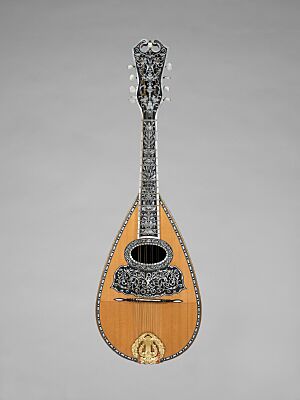
The first six-string guitar was made by Gaetano Vinaccia in Naples in 1779. This instrument is now called the romantic guitar. The Vinaccia family also created the mandolin. Influenced by the Spanish, Neapolitans became leaders in classical guitar music. Ferdinando Carulli and Mauro Giuliani were important players. Giuliani is considered one of the greatest guitar players and composers of the 19th century. Another famous Neapolitan musician was the opera singer Enrico Caruso. He was one of the most famous opera tenors ever. He was seen as a man of the people in Naples, coming from a working-class background.
A popular traditional dance in Southern Italy and Naples is the Tarantella. It started in Apulia and spread throughout the Kingdom of the Two Sicilies. The Neapolitan tarantella is a courtship dance performed by couples. It has faster, more cheerful music.
A notable part of popular Neapolitan music is the Canzone Napoletana style. This is the city's traditional music. It has hundreds of folk songs, some from the 13th century. The style became official in 1835. This was after the annual Festival of Piedigrotta songwriting competition began. Some famous artists in this field include Roberto Murolo and Renato Carosone. There are also other music styles popular in Naples but not well known outside it. These include cantautore ("singer-songwriter") and sceneggiata. The sceneggiata has been called a musical soap opera. The most famous artist in this style is Mario Merola.
Cinema and Television
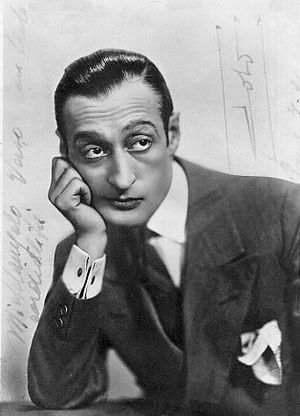
Naples has greatly influenced Italian cinema. Many films and TV shows are set in Naples. Also, many talented actors, actresses, directors, and producers are from Naples.
Naples was the setting for several early Italian film masterpieces. Assunta Spina (1915) was a silent film. It was based on a play by Neapolitan writer Salvatore Di Giacomo. The film was directed by Neapolitan Gustavo Serena.
Here are some well-known films that take place in Naples:
- Shoeshine (1946), directed by Neapolitan, Vittorio De Sica
- Hands over the City (1963), directed by Neapolitan, Francesco Rosi
- Journey to Italy (1954), directed by Roberto Rossellini
- Marriage Italian Style (1964), directed by Neapolitan, Vittorio De Sica
- It Started in Naples (1960), Directed by Melville Shavelson
- The Hand of God (2021), Directed by Paolo Sorrentino
Naples is home to one of the first Italian color films, Toto in Color (1952). It starred Totò (Antonio de Curtis), a famous comedic actor born in Naples.
Some notable comedies set in Naples include Ieri, Oggi e Domani (Yesterday, Today and Tomorrow). This film starred Sophia Loren and Marcello Mastroianni. Other dramatic movies include Dino Risi's Scent of a Woman. War movies include The Four Days of Naples.
More modern Neapolitan films include Ricomincio da tre. This film shows the adventures of a young person moving away in the late 20th century. The 2008 film Gomorrah is based on a book. It explores the dark side of Naples through five stories about the powerful Neapolitan crime group. There is also a TV series of the same name.
Several episodes of the animated series Tom and Jerry also have references to Naples. The song "Santa Lucia" played by Tom Cat has its origins in Naples. The episode Neapolitan Mouse takes place in the city. The Japanese series JoJo's Bizarre Adventure's Part 5, Vento Aureo, also takes place in Naples.
Naples has appeared in TV shows like The Sopranos. It was also in the 1998 version of The Count of Monte Cristo.
Sports in Naples
Football is by far the most popular sport in Naples. The British brought it to the city in the early 20th century. The sport is a big part of local culture. It is popular with everyone, from street children to wealthy professionals. The city's most famous football club is Napoli. They play their home games at the Stadio Maradona. The stadium was renamed after the Argentinian player Diego Maradona. He played for the team for seven years. The team plays in Serie A. They have won the Italian championship three times, the Coppa Italia six times, and the Supercoppa Italiana twice. The team has also won the UEFA Cup.
Naples is the birthplace of many famous professional footballers. These include Ciro Ferrara and Fabio Cannavaro. Cannavaro was captain of Italy's national team until 2010. He led the team to win the 2006 World Cup. He was then named World Player of the Year.
Some of the city's smaller clubs include Sporting Neapolis. The city also has teams in other sports. These include futsal, water polo, and horse racing. The Accademia Nazionale di Scherma is the only place in Italy where you can become a "Master of Sword" or "Master of Kendo".
Neapolitan Tailoring
Neapolitan tailoring started as a way to make English tailoring less stiff. English tailoring was not suitable for the Neapolitan lifestyle. The Neapolitan jacket is shorter and lighter. It has little to no shoulder padding.
International Connections
Sister Cities
Naples is twinned with these cities:
 Gafsa, Tunisia
Gafsa, Tunisia Kragujevac, Serbia
Kragujevac, Serbia Palma de Mallorca, Spain
Palma de Mallorca, Spain Athens, Greece
Athens, Greece Santiago de Cuba, Cuba
Santiago de Cuba, Cuba Santiago de Cuba Province, Cuba
Santiago de Cuba Province, Cuba Nosy Be, Madagascar
Nosy Be, Madagascar Nablus, Palestine
Nablus, Palestine Limerick, Ireland
Limerick, Ireland Sassari, Italy
Sassari, Italy Sulaymaniyah, Iraq
Sulaymaniyah, Iraq
Partnerships
Naples has partnerships with these cities:
Images for kids
See also
 In Spanish: Nápoles para niños
In Spanish: Nápoles para niños









